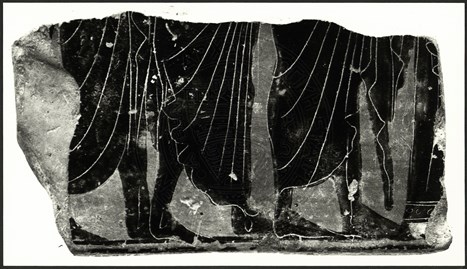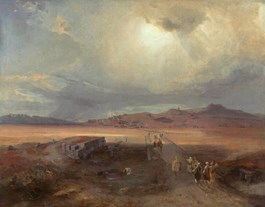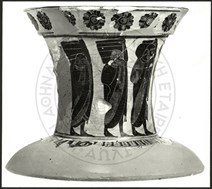The 19th of Boedromion was dedicated to returning the sacred objects to Eleusis accompanied by the prospective mystai. The day started early in two different parts of Athens. First, the priests and priestesses of Demeter gathered in the City Eleusinion to remove the sacred cysts. Then they went down to the Agora following the Panathenaic Way, which passed in front of the temple of Demeter and reached the sanctuary of Iacchus, near the Dipylon Gate. The sanctuary housed the xoanon of the young god depicted holding a torch and crowned with myrtle. The Iakchagogos placed the statue on a carriage and took his place at the head of the procession.
In the meantime, the prospective mystai and mystagogoi gathered at the Pompeion between the Dipylon and Sacred Gates. The mystai wore festive clothes and held branches of myrtle tied with strands of wool (“bacchus”). Many carried a thick staff on their shoulders with a sack of supplies and the new clothes they would wear to their initiation. If the provisions were heavy, the would-be initiates could use a pack animal to carry them (usually a donkey), although they had to walk to Eleusis on foot. The armed ephebes who would accompany the procession also gathered at the Pompeion. They were dressed much like the first day, when they brought the sacred objects from Eleusis, only this time they wore myrtle wreaths.

Pyre Γ. Black-figure panel [marching feet], Konstantina Kokkou-Vyridi, photograph, Εν Αθήναις Αρχαιολογική Εταιρεία © Η εν Αθήναις Αρχαιολογική Εταιρεία
The procession was precisely organised. First, the xoanon of Iacchus and his priest were at the head. Then came the priests and priestesses of Demeter carrying the cysts on their heads. Then there were the state officials, delegations from other Greek cities, the initiates with the mystagogoi, and, finally, the animals carrying supplies. In total, the crowd would have numbered several thousand people, who left for Eleusis under the watchful eye of their fellow citizens, who would not participate in the celebration.

Eleusis, Carl Rottmann, 1843, painting, Bayerische Staatsgemäldesammlungen - Neue Pinakothek München © Bayerische Staatsgemäldesammlungen - Neue Pinakothek München

Pyre Γ. Fragment of a black-figure loutrophoros-amphora with a procession of men, Konstantina Kokkou-Vyridi, photograph, Εν Αθήναις Αρχαιολογική Εταιρεία © Η εν Αθήναις Αρχαιολογική Εταιρεία
Eleusis is about twenty-three kilometres from Athens. The procession stopped at various points along the Sacred Way for ceremonies, sacred dances, hymns, sacrifices, and libations in honour of the gods they met on their way. The crowd shouted the name of Iacchus and proceeded with enthusiasm, despite the inevitable heat and dust raised by the footsteps of so many thousands of people and animals. Arriving in Eleusis at sunset would be the highlight of the day. In the light of the lit torches, the participants reached the spacious courtyard in front of the sanctuary and saw one of the most important landmarks of Eleusis: the Kallichoron well. As night fell, the prospective mystai attended the kernophoria, a dance by women balancing the kernos (the pre-eminent vessel of the Mysteries) on their heads. After the ceremony, the crowd scattered in the city, searching for accommodation for the evening. Some would spend the night in inns, while relatives or friends would host the luckiest. Most would spend the night under the stars, but the excitement of the procession and the anticipation for the upcoming ceremonies would justify any inconvenience.

Plan of the plain of Athens, David Le Roy, 1758, engraving, Bibliothèque nationale de France / Département des Cartes et plans © Bibliothèque nationale de France / Département des Cartes et plans








